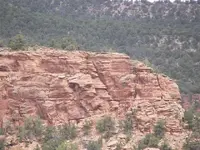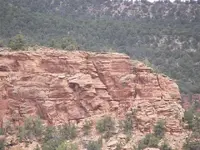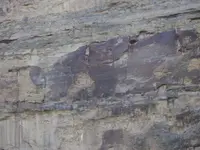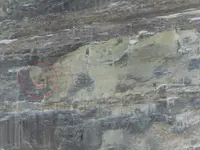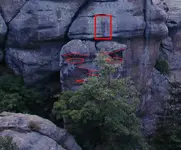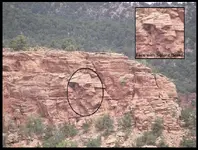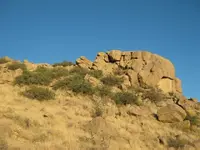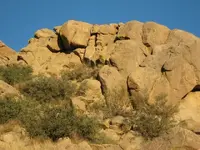Kim,
remember I said..
............
so we are not here to "prove" beyond a shadow of doubt
(that the Ancients ones where here in America)
..only to OPEN the discussion.
Regarding the disparaging of Fell..my research reveals...'the rest of the story'...
but first take a look at this site in Inyo, Southern California, where carbon 14 dating
revealed that the calcium 'rind' covering part of the inscription was found to be 2000 years old
and that was when the inscription was covered! So the writing on the rocks is far old than that!
a 10 minute video about the Inyo in southern california,
that Barry Fell interpreted as an Arab/derived symbols meaning to celebrate the equinox.
The reason Barry was discredited is because his theories and interpretation of the marks meant
that the people from the Mid east where in southern california at least 2000 years before Columbus
and since that did not fit the paradigm - and was outed ala political correctness.
To get to the real truth of the matter, we must look beyond the accepted "story"
who's parameters are protected by the powers that be, just be careful that we
do not slip in to that mind set, just because some critic says so..
Know that Barry Fell was a Harvard grad and published 200 papers on interpreting
a whole host of languages, he was THE expert at the time. The naysayers didnt like the idea of any
BUT Columbus discovering America, so they trashed him..lets not let that abuse continue to this day.
...lets do the research and read the documents and discern the truth for yourself.
http://www.faculty.ucr.edu/~legneref/bronze/fellview.htm
Now the genius of Dr Fell has caused a mind-boggling change in attitude on the subject of American colonization. In his published book, America B.C., New Zealand-born Barry Fell, a marine biologist at Harvard, offered astonishing evidence that there were men and women from Europe, not merely exploring but living in North America as early as 800 B.C. This was followed by additional books in 1982, 1983, 1985 and 1989 where the dates of such colonization were pushed back to as early as 1700 B.C. (See Bronze)
These early settlers worked as miners, tanners and trappers, and shipped their products back to Europe. In temples in the rugged hills of New Hampshire and Vermont (Sce Photos-1 & Photos-2) and in river valleys in Iowa and Oklahoma they sang hymns and performed sacred rituals to honor their gods. When their kings or chiefs died, they buried them beneath huge mounds of earth in which they left steles—written testimony of their grief carved on stone.
Some of these steles had been discovered as early as the 19th Century, and people had puzzled over strange incscriptions carved on cliffs from the Maine coast to the Rio Grande and west to Nevada and California, or on stones that lay in obscure museums. But archeologists could not read the ancient writings and dismissed these mysteries as forgeries or accidents of nature. Dr. Fell’s exepertise in this field known as epigraphy, which requires many of the gifts intelligent persons bring to code-cracking, is the tool which has enabled him to add a thousand years or more to America’s past. Fell first became interested in ancient languages while a student at the University of Edinburgh. He learned Gaelic, and began to investigate Celtic tombs and ruins in Scotland. Then, in a study of the marine biology of Polynesia, he found hundreds of unreadable inscriptions engraved on rocks and painted on cavern walls.
Intrigued, Fell came to Harvard in 1964 and spent the next eight years exploring the Widener Library’s unique collection of texts on obscure languages and writing systems. In the course of this effort he acquired a working knowledge of several ancient alphabets, including the hieroglyphics of the Egyptians = Punic); the script of the Carthaginians and Ogam, an almost forgotten script used by the pre-Christian Norse (often erroneously referred to as Celts—See Celts).
Fell finally proved to his satisfaction that the Polynesian inscriptions were written in the native language, Maori. But its vocabulary was a mixture of Greek and Egyptian that was once spoken in Libya after Alexander the Great conquered Egypt. The alphabet was derived from Carthage.
The most remarkable of these Libyan texts was found in a huge cave in New Guinea. There a navigator named Maui left drawings of ancient but sophisticated astronomical and navigational instruments, as well as a depiction of a solar eclipse that enabled Fell, with the help of Harvard astronomers, to identify the year of the drawings as 232 B.C.
If these were Libyans visiting Polynesia at that time, Fell reasoned perhaps they sailed on to South America. He soon accumulated evidence for such landfalls and began lecturing on it at Harvard. His talks attracted the attention of a group of investigators led by James P. Wittall II, an archeologist, who had noted the similarity between numerous crude stone buildings in New England which farmers often called root cellars, and similar ruins in Spain and Portugal. The European buildings had been identified as creations of Celts who ruled that part of Europe during the Bronze Age, the period of prehistory, which dates roughly from 3500 B.C.
Whittall asked Fell to take a look at the Bourne stone, which had been discovered near Bourne, Massachusetts around 1680. (Scan Photos) No one had ever been able to make any sense of the writing on it. Now, Dr. Fell was able to read it. The letters were a variation of the Punic alphabet, found in ancient Spain, for which Fell had coined the word “Iberic.” It recorded the annexation of a large portion of present-day Massachusetts by Hanno, a prince of Carthage. Fell joined in a search for additional inscriptions at one of their favorite sites, Mystery Hill in North Salem, N.H.. (Scan Photos) This site consists of a series of slabstone buildings, variously attributed to Norsemen, wandering Irish monks, and a vanished tribe of Indians. Studying the inscribed triangular stones, which had previously been found at the site, Fell found a dedication to the Phoenician god Baal, written in Iberic. Then promptly other people began to See hitherto unnoticed inscriptions in the area. The owner of Mystery Hill, Bob Stone found another table in an adjacent drystone wall. When Fell brushed away the adhering soil, he was able to read a line of Ogam script that read “Dedicated to Bel.”
Students of ancient mythology had long suspected that the Celtic sun god Bel and the Carthaginian-Phoenician god Ball were identical. Here, for the first time, there was evidence not only of this fact, but of a Celtic-Carthaginian partnership in exploration and settlement on a scale previously never even imagined.
In the following days Other Ogam inscriptions were located at another site in central Vermont (Scan Photos). Fell noted that it became clear that ancient Celts had build these stone chambers as religious shrines, and the Carthaginian mariners were visitors who were permitted to worship at them and make dedications in their own language to their own gods.
Then Whittall showed Fell a photograph of an inscription engraved on a cliff above Mount Hope Bay, in Bristol, Rhode Island, which was discovered and recorded in 1780. Because of vandalization, it was necessary to work from the photograph. Fell soon translated a single line, which was written in Punic: “Voyagers from Tarshish this stone proclaims.”
Tarshish was a Biblical city on the southern coast of Spain, and its citizens were among the boldest sailors of antiquity, famous for the size of their ships. In 533 B.C., the Carthaginians and their trade taken over by these ambitious, daring sailors destroyed Tarshish. Here was evidence of how the partnership between Celts and the Carthaginians began.
~~~
The complacency of protecting the belief system of modern academe is shown by
the ways they attempt to discredit anyone who tries to prove the old paradigm is dead, and that new evidence
has surfaced and a new day of understanding is at hand. That is why the school books to this day still say
Columbus 'sailed the ocean blue, and discovered America in 1492'. Now that can be seen as a moronic tune
outdated, outmoded, outvoted, outcast, and overwritten by volumes of proof that American was well trodden
centuries before Old Chris and his noble crew..sailed the ocean blue!
http://www.equinox-project.com/zodia.htm
http://www.equinox-project.com/indexfell.htm
this link lists his 200 papers over his lifetime
to discredit this genius in his field, shows to
what ends 'conventional wisdom' will go to
protect the ivory towered misconceptions!
a word about artifacts......
As of March 2005 there have been few implements found in the Americas that date from the Bronze Age. Nevertheless, there is considerable evidence of a voyage or voyages of a Bronze Age Scandinavian king, Woden-lithi, to North America around 1700 B.C. from texts found inscribed in the rocks at Peterborough, Ontario, Canada , and other North American sites and other sites.
These texts, written in Teutonic and Norse tongues, used alphabets that have survived to the present in remote parts of the world. However, in Europe Roman script became the predominant alphabet around the time of Christ as part of the general occupation. They support the belief that Europeans during the Bronze Age were literate, educated people.
Harvard Professor Barry Fell (1982) has attempted to translate the inscriptions to about October 2000. Expected widespread criticism of such new ideas flooded the archeological world. Yet by the year 2005 there has emerged a revolution in American prehistory that may finally remove antiquated biases and enable concerted efforts at learning and dispelling myths about colonization in America
. The evidence points to the certainty that European colonists and traders have been visiting or settling in the Americas for thousands of years, have introduced their scripts, artifacts, and skills, and have exported abroad American products such as copper and furs. The voyages occurred just as the Iron Age was beginning, so that the explorers might have brought with them implements of iron instead of bronze and most could have eventually rusted away.
I rest my case
rangler
"seekers of fortune and of knowledge, never get their fill"....... old Arab saying.





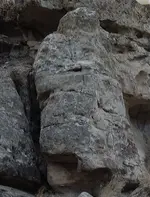
 " "
" "
